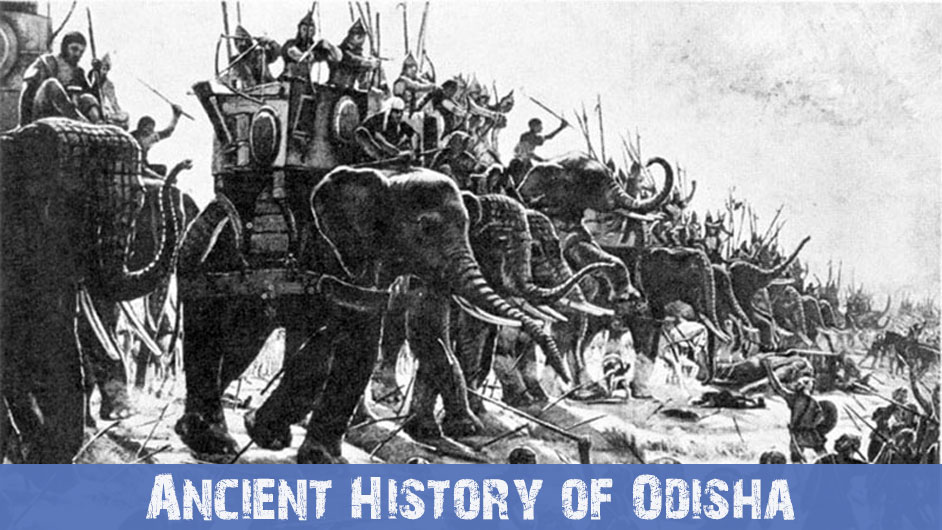Ancient History of Odisha
The name Odia originated from Odra or Udra tribes residing in the central coastal belt of modern Odisha.
Human history in Odisha dates back to the Lower Paleolithic era, which is evident by archaeological sources from different regions of the state.

• The Mauryan dynasty, under Emperor Asoka, integrated Kalinga into their empire after the famous Kalinga War in 260 BC, leading to Asoka’s transformation and adoption of Buddhism.
• Historical names of Odisha include Kalinga, Utkala. Odra, Oddiyana, Kamala Mandala, South Kosala, Kongoda, Trikalinga, Tosali, Odivissa and Jajnagar.
Each of these reflecting different periods and aspects of the region.
• Literary sources such as the Mahabharata, Ramayana, Puranas, Jain and Buddhist texts provide insights into the ancient history and culture of Odisha.
•Foreign accounts, including Greek historians like Pliny, Diodorus, Curtius, Plutarch and Chinese pilgrim Hiuen Tsang, give valuable information about the people and conditions in Kalinga.
• Archaeological sources, including Asokan Rock Edicts, rock shelters, cave paintings and excavations at various sites like Dhauli, Jaugada. Udayagiri and Lalitgiri, contribute to understand the ancient history of Odisha.
• Inscriptions, such as the Hatigumpha inscription, Bhadra inscription and others found on copper plates, stones and temple walls, provide details about rulers, administrative systems and early history.
• The language Hatigumpha inscription found from Dhaulagiri hills Odisha is Pali.
• The study of coins (numismatics) reveals the use of Punch-marked coins, Puri-Kushana coins, Gupta coins and Nala coins during different periods in Odisha.
• The Laxmanesvara, Bharatesvara and Satrughnesvara group of temples marked the early phase of temple architecture in Odisha.
• The construction of the Lingaraja temple at Bhubaneswar was initiated by Chandihara Yayati II and completed by Udyotakesari Mahabhavagupta during the Somavamsi rule.
• Newspapers and periodicals like Utkala Deepika, Utkala Darpan, Asha, Mukuru, Sahakar, as well as Census reports from 1801 to 1931, are crucial archival materials for understanding the history of Ouisha.
• Odisha’s land, part of the Gondwana supercontinent, contains pre-historic sites with lower Paleolithic tools in Mayurbhanj. Keonjhar, Sundargarh and Sambalpur.
• Kalinga was integrated into the Magadha empire by Mahapadma Nanda of the Nanda dynasty around 350 BC. The Hathigumpha inscription at Udayagiri mentions Nanda rule and its economic prosperity.
• Chandragupta Maurya established the Mauryan empire in Magadha in 322 BC, defeating Dhana Nanda, the last Nanda ruler The subsequent history of Kalinga’s independence is uncertain.
• The Battle of Kalinga in 260 BC between the Mauryan empire and Kalinga led to massive destruction.
Asoka became Buddhist after the war.
•The Mahameghavahana/Chedi dynasty, with Kharavela as a notable ruler in the 1st century BC, played a significant role in the post-Mauryan period.
• The Gupta dynasty existed from the mid-3rd century to 590 AD. Samudragupta’s campaigns divided Kalinga into principalities. The Matharas and Nala dynasties emerged during this period.
• The Sailodbhava dynasty, established by Ranabhita in 553 AD, played a significant role in the region.
• The Bhauma-Kara dynasty, ruling in the 8th century AD, had stable administration, engaged in cloth manufacturing and had commercial relations with Ceylon, China and South-East Asia.
• Female rulers like Tribhuvana Mahadevi I, Tribhuvana Mahadevi II and Tribhuvana Mahadevi III played significant roles in the Bhauma-Kara dynasty.
• The Somavamsi dynasty, from the 9th to 12th century AD, unified Kalinga, Utkala, Kongoda and Kosala under one political authority, leading to a cultural synthesis.
• Important rulers of the Somavamsi dynasty include Mahabhavagupta Janmejaya I, Mahasivagupta Yayati I, Bhimaratha Mahasivagupta I, Janmejaya II, Puranjaya I and Karnadeva.